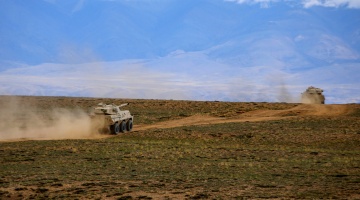By Hai Ning

Polish soldiers participate in NATO's Integrated Air and Missile Defense exercise in mid-June, 2024.
A ceremony was held on July 1stby NATO in Solbiate Olona, Province of Varese, Italy to officially launch a new fast response force, the Allied Reaction Force (ARF).
Upgraded force
Building fast response forces is nothing new. NATO, ever since its establishment, has made repeated attempts to build and improve its fast response force to cope with so-called military threats.
NATO had an "Allied Command Europe Mobile Force (AMF)", a small quick reaction force, during the Cold War, which was replaced by the NATO Response Force (NRF) in November 2002, the organization's dominant fast response force so far that comprises army, naval, air, and special operation forces. NATO also set up within NRF a "spearhead force", known as the Very High Readiness Joint Task Force (VJTF), which is a roughly 5,000-strong multi-national army brigade comprising five battalions with enhanced naval, air and special forces.
After the Russia-Ukraine conflict broke out in 2022, NATO announced that it would swell the NRF to about 300,000 troops gradually and the VJTF to around 20,000 troops. According to NATO's Secretary General Stoltenberg, it is the most extensive reconfiguration of the organization's collective defense and deterrence capabilities since the Cold War.
Revised capability requirements
In 2014, NATO shifted its "main duty" from "global counter-terrorism" to "collective defense", requiring NRF, comprising 30 mechanized battalions, 30 air squadrons, and 30 combat vessels, to get ready within 30 days (45 at most) to enter and control the battlefield, and its "spearhead force" to be ready for deployment within two or three days.
According to NATO's Allied Command Operations (ACO), the new ARF comprises cyber and air forces and several light infantry forces that can be mobilized at short notice. "The ARF can deliver forces, fires and effects within 10 days to either strengthen deterrence or impose strategic dilemma on adversaries.”Headquartered in Italy, it will be in direct charge of the 1st Division of the British Army, Spanish Special Operations Command, NATO's Naval Striking and Support Forces, Command of the Italian Maritime Forces, and NATO's Space Center and Cyber Defense Center.
A herald of transformation
The performance indicators of the newly formed ARF give a glimpse of the trend of NATO's new round of military transformation.
Its New Strategic Concept issued in June 2022 labeled Russia as the biggest and most immediate threat, and put forth three key tasks for the next ten years – deterrence and defense, crisis prevention and management, and cooperative security. Correspondingly, the organization presented a new defense approach that emphasized the fast deployment capability of its troops and covered more topics under the security umbrella. As a result, the scope of NATO's defense capacity building is also expanded to include key infrastructure, emerging and disruptive technologies, outer space, and other domains.
Since the 2022 summit in Madrid, NATO's military buildup has made a series of substantial progress – increasing military spending, intensifying forward defense, swelling the high readiness force, upgrading the command and control system, refining joint military exercises, and admitting Finland and Sweden as new members…For NATO, the possibility of a protracted Russia-Ukraine conflict demands that its members reach a consensus on "more capital, more combat forces, more capabilities, and more cooperation". They must also be made more prepared to tackle "mixed threats" (e.g. cyber-attacks and attacks on key infrastructure).
NATO announced the start-up of the new ARF and its command organization on the eve of the Washington Summit in order to fan up the momentum for the summit, showcase the results of its military buildup, and create a sample for the future expansion and maintenance of its fast reaction forces. The announcement fully revealed NATO's ingrained security outlook characterized by confrontation, expansion and exclusivity and its insistence on military expansion for war despite its self-claim as a defensive organization. This will deal a heavy blow to the regional situation and the international order.









